Top News
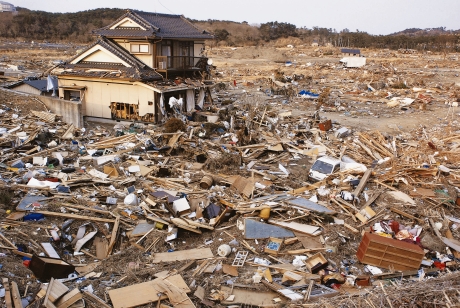
April 4, 2011, by Hideki Matsudo, staff writer of Ryukyu Shimpo, in Miyagi Prefecture
The catastrophe in northeastern Japan has inflicted the worst damage on the country since the end of World War II. Now scarred by the earthquake and tsunami, Miyagi Prefecture is home to many people from Okinawa. Among them there are men and women who only barely escaped with their lives before spending a distressing period of time in an emergency evacuation center, and others who lost family members or still cannot be contacted. Three weeks have passed since the disastrous events of March 11, so now people are moving to start reconstructing their towns and villages.
“It looks like somewhere that has been totally devastated by war,” said Toshifumi Kinjo, who hails from Motobu in the northern part of Okinawa. He was lost his words when he first saw the ruins of the town in Miyagi that he had come to call home.
Oil and gas storage facilities in Tagajo City went up in flames immediately after the earthquake, leaving the city veiled in dust with the sickly smell of oil lingering in the salt air. Yasuteru Shiohama, Chairman of the Okinawa Kenjin-Kai (organization of people from Okinawa) in Miyagi, said that most people had been confirmed as being safe, but that he was unable to make contact with non-members.
Reinforced concrete buildings and large commercial facilities had only just maintained their original form, with most of the houses and residents in the coastal area of the city being washed away by the huge tsunami. There is a heavy toll of lives and missing people. Shiohama sighed as he said, “This is what it looks like after we have done some tidying up. How do we restore the city from this? They say that the amount of rubble is equivalent to the quantity of refuse generated over 25 years.”
In Ishinomaki, the most severely affected city of Miyagi Prefecture, there were dramatic scenes of a boat that had been washed ashore by the tsunami, to be then left stuck in the side of a building, and of a taxi with the key in it but dropped down in a hole in a road.
It will take a long, long time for the affected areas to recover.
(English Translation by T&CT, Mark Ealey)
Go To Japanese
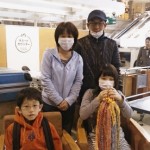
April 6 2011, Ryukyu Shimpo.
Miyu Kaname, a 13 year-old girl attending Kamimori Junior High School in Urasoe City in Okinawa, is afflicted with restrictive cardiomyopathy, for which the only treatment is a heart transplant. After arriving in the United States at around 1:15 am Japanese time on April 6, she is now waiting in New York for a donor to be found. She is scheduled to go into New York’s Columbia University Hospital for several days before moving to housing to wait for a donor.
Escorted by a doctor, her father, mother and 8 year-old younger brother, she departed from Fukuoka, where she had been admitted to Kyushu University Hospital, making a stopover at Narita on her way to New York.
On the morning of their departure to United States, when they received words of encouragement from doctors and nurses at Kyushu University Hospital, Miyu’s mother Naomi said that her daughter seemed a little nervous, but relatively well, and that she hoped that Miyu would be able to undergo surgery soon.
Father Toshiaki told the Ryukyu Shimpo that, “We will do out best to ensure that Miyu comes back recovered from illness to thank all the Okinawan people who supported her through the fund-raising campaign.” Naomi said, “We are very grateful to everyone for the fact that we are now standing on the start line with our daughter. We will return home to Okinawa with Miyu and her cheerful smile.”
(English Translation by T&CT, Mark Ealey)
Go To Japanese
April 4, 2011 Ryukyu Shimpo
The Ministry of Education, Culture, Sports, Science and Technology (MEXT) has announced the results of screening of junior high school history textbooks to be used from the 2012 academic year. However, doubts remain as to whether the content adequately covers the minimum facts that should be conveyed to next generation.
With regard to the Battle of Okinawa, all the seven companies that applied to publish textbooks made mention of “group suicide,” (shuudan jiketsu). Four of those seven mentioned that civilians felt driven to commit suicide and that the Japanese Army was involved, but did not make it clear whether or not the military ordered or compelled them to take their own lives.
The people of Okinawa were caught up in the fierce fighting that occurred between the Japanese and US armies 66 years ago at this very time of year. The mission of the Japanese 32nd Army, deployed to defend Okinawa, was to contain the US forces there for as long as possible to allow preparations to be made for a decisive struggle on the main islands of Japan. But during the fighting, rather than protecting the civilians’ lives and property, the Japanese Army was guilty of taking them.
In 2007, in a meeting of the House of Representatives Budget Committee, Prime Minister Naoto Kan, then acting head of the Democratic Party, stated that, “There can be no denial the Japanese military was involved in incidents of group suicide by civilians in the Battle of Okinawa.” He criticized the intervention of MEXT in the textbook screening process, calling for Yasuo Fukuda, then prime minister, to withdraw the result of the screening.
This was when those civilians who somehow managed to survive the battle of Okinawa, became united, and spoke up to demand the retraction of the screening result.
The seven companies that applied to publish school textbooks all used the expression “group suicide” (shuudan jiketsu), but this is insufficient by itself because the textbooks do not make it clear that civilians were actually compelled by their own military to kill themselves.
The Ministry needs to make the screening process of school textbooks transparent and explain to people how matters are discussed and conclusions reached. It is also a problem if textbook authors or publishers hold back, mindful of the Ministry screening. They should be prepared to present their own views.
Education or textbooks that chooses to ignore the mistakes of the past, could serve to jeopardize the future of our country.
(English Translation by T&CT, Mark Ealey)
Go To Japanese

March 31, 2011 Ryukyu Shimpo
Publishing company Nihon Bunkyo Shuppan has introduced “Color The World,” an artwork by Yuken Teruya, in a junior high school art textbook.
Originally from Haebaru, Okinawa, Yuken Teruya now resides in New York City.
His artwork “Color The World” is made up of the national flags from 196 nations and regions of the world. Teruya says that he created it in an attempt to take a step towards a solution for the intangible unrest that he senses has lingered in society since the September 11 2001 terrorist attacks on the United States.
Seeing New York filled with Stars and Stripes flags after 9/11, Teruya felt that while a national flag can serve to bring people together, it also excludes people who do not fall into the category represented by that specific flag. This experience motivated him to create the artwork. Teruya made the sizes of all the national flags the same and arranged them like a map of the world. By doing this, he said, “I think it shows one of the ways in which people all around the world can view each other as equals.”
His artwork tells us that nations near each other have common patterns in their flag designs and that those nations and adjacent neighbors are actually linked. Teruya said, “I think that expressing unease and issues in a shared form may help lead us to a solution.”
Nihon Bunkyo Shuppan explained why it introduced his work in the junior high school art textbook, saying, “This artwork poses the question: ‘What is peace?’ We would like junior high school students to think about issues of war and peace in today’s society.”
(English Translation by T&CT, Mark Ealey)
Go To Japanese
March 31, 2011 Ryukyu Shimpo
On March 30, the Ministry of Education, Culture, Sports, Science and Technology announced the screening results for junior high school textbooks to be used from the 2012 academic year.
With regard to the description of the battle of Okinawa in history textbooks, all seven companies that applied to publish school textbooks made mention of “group suicide” (shuudan jiketsu), in which the Japanese military ordered or forced civilians to commit suicide.
While the Ministry approved the mention of “group suicide” in the textbooks submitted by publishers without comment, there are differences among the publishers regarding the description of Japanese military forces’ involvement.
In Civics textbooks, three companies touched upon the relocation and return of the facilities at the Futenma Air Station, giving a more detailed description of issues related to US military bases in Okinawa than in previous years.
In the 2004 screening, which approved the textbooks currently used, only five companies referred to “group suicide.” A further two companies did so this time.
Following strong protests by the Okinawan people against the results of the 2007 screening, which approved textbooks that removed mention that the Japanese Army ordered civilians to commit suicide in the Battle of Okinawa, and discussion at the Screening Committee, textbook publishers paid greater attention to the content of their description of this matter.
Four out of the seven companies wrote that civilians were forced to take their own lives, and that the Japanese military was involved in this, but the books do not clearly describe whether or not the Army actually ordered or forced civilians to kill themselves.
Among the textbook companies, Tokyo Shoseki states that, “Some civilians were driven to commit suicide by the Japanese military.
” The Shimizu Shoin text states that, “Many civilians also used hand-grenades distributed by Japanese military personnel or local officials to commit suicide in groups, including entire families.”
Adding an explanation to a picture of a gama or natural cave used by soldiers and Okinawan citizens to shelter in, the Teikoku Shoin textbook includes mention that, “Teenagers were forced to commit suicide using grenades given out by the Japanese military.”
In the Kyoiku Shuppan text they stated, “Some local civilians were killed by the Japanese military after being suspected of being spies and others were forced to commit suicide in groups.”
(English Translation by T&CT, Mark Ealey)
Go To Japanese
March 31, 2011. Ryukyu Shimpo
According to Kahoku Shimpo, a local newspaper in Miyagi Prefecture, false rumors are being spread through the areas stricken by Great East Japan Earthquake. The rumors are to the effect that, “Chinese are stealing relief supplies,” “Sex crimes are occurring all over the place,” “You will be irradiated if you get wet in the rain,” and “Murder-robberies are occurring one after another.”
Such false information has been spread not only through personal communication but also through e-mails and Twitter, reflecting just where society is at the moment. The rumors are so widespread that Miyagi Prefectural Police have distributed leaflets urging people not believe incorrect information.
A deep sense of concern and a shortage of information have sparked the spread of those rumors. Experts state that it is important for people to connect with reliable sources of information such as news reports, and that we must be wary of hearsay circulating as cell-phone text messaging.
When the Great Kanto Earthquake struck in 1923, hundreds or even thousands of people were killed due to false rumors that, “Koreans have poisoned water wells.” The fact that 16 newspaper companies were destroyed, shutting down the supply of information, was also a factor behind such massacres.
When the Great Hanshin Earthquake occurred in 1995, a rumor circulated that an earthquake of 6.0 on the Japanese scale was imminent, but the Japan Meteorological Agency moved quickly to provide correct information and thereby ease public disquiet.
There is an all-pervading concern regarding the radioactive discharge from Fukushima No. 1 Nuclear Power Plant. The Japanese government’s public statements seem to be contradictory, in that while on the one hand they state that radiation has exceeded regulatory levels, leading to limitations on product shipments, on the other they state that there is no immediate adverse effect on human health. We don’t know which to believe, so concern over the current situation grows.
American author Mark Twain is quoted as saying that “a lie can travel half way round the world while the truth is putting on its shoes.”
In times of emergency, information must be delivered accurately, quickly and in an easily understandable manner. The Japanese government and the Tokyo Electric Power Company both need to understand the concerns of the Japanese people and to take them to heart.
(English Translation by T&CT, Mark Ealey)
Go To Japanese
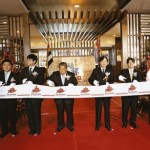
March 30, 2011. Ryukyu Shimpo
The Okinawa Prefectural Government (OPG) has set up a second “antenna shop” called “Wasabi” (meaning beauty and peace) in Shanghai Province, China. The concept behind “antenna shops” is to promote the produce of a certain region, and this shop introduces Okinawan food culture to local Chinese people, both through its restaurant, which has seafood dishes made with ingredients from Okinawa on the menu, and its shop, which sells sweets and lumps of brown sugar.
The 800 square-meter premises are managed by the Shanghai firm, Ras Ai Khaimah Trade Co., Ltd. Okinawan and local Shanghai people involved in the project celebrated the shop’s opening by listening to a sanshin music performance and sampling some delicious Okinawan food at the opening event held on March 25.
In his speech, OPG office staff member Tsunemi Tamaki said that he hopes that the Shanghai shop will provide a spark to help promote Okinawan products all over China. Setsu Ritsukou, Director of the Shanghai Ras Ai Khaimah Trade Co., said that they intend to take up where the old Ryukyu Kingdom left off in assuming the role of “Bankoku Shinryo” (a bridge between nations) to offer information about Okinawa to the outside world.
OPG now has seven “antenna shops” abroad including premises in Shanghai, Hong Kong and Taipei that are part of the “Okinawa International Airlines Logistics Hub Deployment Project,” in which All Nippon Airways plays a leading role. OPG pays for the hire of the premises and local companies manage the shops.
(English Translation by T&CT, Mark Ealey)
Go To Japanese
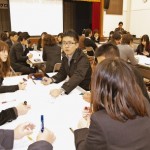
March 27, 2011. Ryukyu Shimpo
The “Global Next Generation Project,” the pre-event of the 5th Worldwide Uchinanchu Festival, was held in the hall of University of the Ryukyus on March 26.
During the event, local Okinawan students who have experienced exchanges with people of Okinawan descent residing abroad or with people from other countries, reported on their experiences and talked about establishing a network with the increasing number of Okinawans or people of Okinawan descent who live overseas.
The event was designed to enhance the potential of the 5th Worldwide Uchinanchu Festival scheduled for October.
The students and working people who participated, approximately 100 in total, decided to hold further study sessions roughly once a month from now in an attempt to stimulate discussion in the time leading up to the Festival itself.
The students spoke of the benefits of their experiences going on study trips to countries such as the United States, China and South Korea, saying things such as “I would like to travel around the world and learn many things so I can contribute to Okinawa,” and “I realized the importance of human relationships.” In the small-group discussions that followed, some suggested that there is a need for a place for young people to connect with people from other countries.
Reporting on her experiences during a study trip to the United States, Miki Miyagi, a sophomore student of University of the Ryukyus, said, “Not just adults, but us young people also need to try to contribute to Okinawa’s relationship with the outside world,” and continued, saying that, “It is important for us to have exchange experiences in the Uchinanchu Festival, but we must then work hard to keep those relationships going.”
(English Translation by T&CT, Mark Ealey)
Go To japanese
March 24, 2011. Ryukyu Shimpo
The Okinawa Awamori Distillers Association, headed by Takeshi Sakumoto, announced figures on shipments of Awamori for 2010 on March 20.
Total shipment quantity of 22180 kiloliters was down 5.2% on the previous year, the sixth consecutive annual decrease. This represents 80% of that for 2004, when the shipment figures reached their peak.
While shipments to other prefectures dropped markedly by 8.8%, shipments within the prefecture also dropped by 4.5%. In 2010, shipments within the prefecture totaled 18658 kiloliters, 87% of the 2004 peak figure, with those to other prefectures amounting to 3522 kiloliters, 56% of the peak.
The Okinawa Awamori Distillers Association pointed out that the nationwide shochu (distilled spirit) boom has slowed down and that old vintages have become rather expensive due to deflation. This, combined with the falling population and the fact that young people’s tastes are moving away from alcoholic beverages, has caused a nationwide decline in Awamori shipments.
Kenji Shikina, vice-president of the Association, suggests that the reason for the decline lies in the fact that more people in other prefectures are now seeking to buy cheap but good quality alcoholic beverages, something which runs counter to the strategy of adding high value on old vintages. He added, “Awamori is well-known in other prefectures. We have to be patient for a while and do our best to boost its popularity.”
(English Translation by T&CT, Mark Ealey)
Go To Japanese
March 24, 2011. Ryukyu Shimpo
The Upper House Budget Committee, headed by Takeshi Maeda, held a public hearing on “Foreign and Security Policy” on March 23. During the hearing, Ukeru Magosaki, former Director General of the Intelligence and Analysis Bureau in the Ministry of Foreign Affairs and former Ambassador to Iran, suggested that the Futenma relocation plan should be reviewed, stating that the people of Okinawa people will never accept a relocation within their prefecture. Magosaki also said that claiming that something impossible can be achieved could have far-reaching negative consequences for Japan-US relations, and pointed out that the ructions surrounding Futenma would not fundamentally alter the nature of military cooperation between Japan and the United States.
In addition to Magosaki, Takushoku University professor Satoshi Morimoto, an expert in national security and international policy issues, and Keiko Sakai, a professor at Tokyo University of Foreign Studies, who specializes in modern Middle Eastern politics and Iraqi politics, attended the hearing. They both commented on Japan’s crisis-management systems in the context of the Great East Japan Earthquake and the situation in Libya and Egypt.
With regard to the Japanese government’s handling of the issue of sovereignty over the Senkaku Islands, Magosaki stated that Japan should seek to resolve the issue through diplomatic rather than military means, such as using the Japanese Coast Guard and Self-Defense Forces. Citing the existence of the Japan-China Fisheries Pact and the fact that both governments agreed to shelve territorial issues for the moment, Magosaki said that when Chinese fishing vessels swarmed around the islands back in 1978, the Chinese government stepped in to make them withdraw.
Morimoto, on the other hand, claimed that because China will undoubtedly attempt to take control of the South China Sea, Japan should look to strengthen its grip on the Senkaku islands. He stated that diplomacy is the preferred approach, but suggested that national security was all about having a contingency plan to use when diplomacy fails.
Magosaki explained that while Japan will see a growing military threat from China, it will also see two separate groups within Chinese government; one that tries to settle issues by military means, and the other that tries to exercise control on world affairs by implementing close and peaceful relations with foreign countries. He sees the latter group as being the more dominant of the two. On this basis, he stated that, “Japan should strive to work with the group in China that is looking to contribute to world stability and to develop its own economy.”
(English Translation by T&CT, Mark Ealey)
Go To Japanese
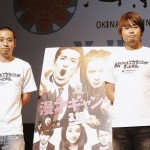
“Laugh & Peace Festival” starts in Okinawa
March 19, 2011, Ryukyu Shimpo
The opening ceremony of the 3rd International Okinawa Film Festival, sponsored by the Festival Executive Committee, was held at Ginowan Tropical Beach in Okinawa, on March 23. Held under the banner: “Yell to support, Laugh and Peace,” the event was designed to raise money for the victims of the huge earthquake and tsunami that struck Tohoku in mainland Japan. At the opening ceremony, the audience, performers and distinguished guests paid their respects to those who lost their lives with a minute’s silence.
Proceeds from the sale of various characters goods and other money raised during the Festival will be donated to the people of the areas affected by the disaster through the Red Cross. Prior to the opening ceremony, dressed in matching T-shirts printed with the words: “There will be something that we can do,” actresses and comedians from all over the country, and from abroad, walked along a 300-meter long red carpet onto the stage. The celebrities responded with smiles to cheering from the large crowd that gathered despite light rain falling.
(English Translation by T&CT, Mark Ealey)
Go To Japanese






 Webcam(Kokusai Street)
Webcam(Kokusai Street)


